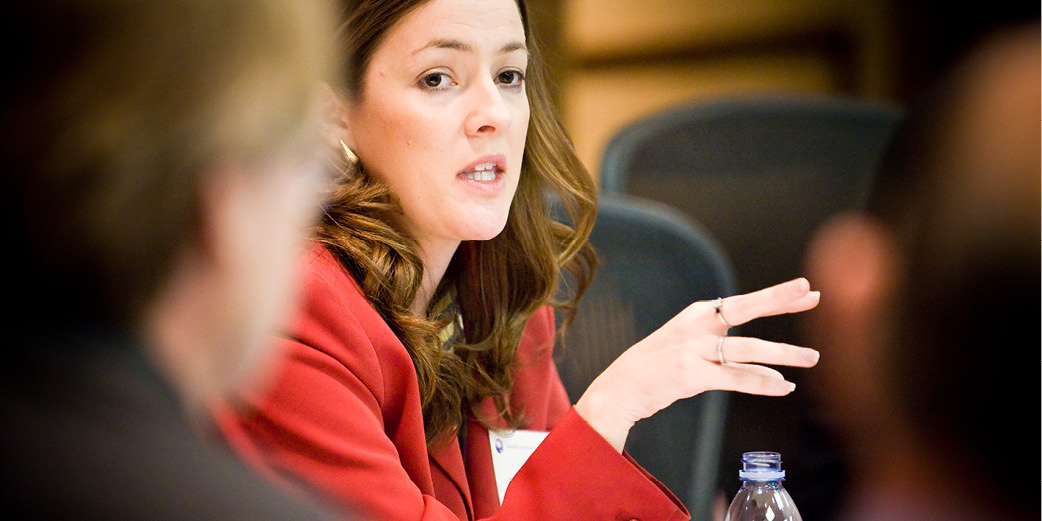Mayer, Sandberg, Slaughter: Driving Change, at a Cost
17 May. 2013 | Comments (0)
![]()
Working women have been calling for more seats in the boardroom, more days of paid maternity leave, more corner offices, more money, and more — well, more! for a long time. So why does it seem like we've only now reached a dull roar on these issues — maybe even what some are calling the rise of "executive feminism"? And can we see signals in the noise?
To explain the sudden surge of discussion on this topic, look to the magic of three: Marissa Mayer, Sheryl Sandberg, and Anne-Marie Slaughter. Would any one of these women been sufficient to jump-start the conversation on their own? No. Slaughter, Sandberg and Mayer are at different stages of their careers and lives, and have very different ideas around a woman's relationship to work and home. It's not despite, but because of, these different stances that they are moving the conversation forward. And so often when someone is talking about one of the three on social media, at least one or both of the other are mentioned. This is one of the reasons research has found that in order to experience the benefits of diversity (better risk management, higher creativity, etc) on a board you need three women; one or even two aren't enough to create real change. You need critical mass, but you also need each woman to feel like she's advocating her point of view — not "Woman's Point of View."
To get a sense of the scale of the conversation that these women have launched, we monitored the billions of conversations that occur in real-time on social media through the NetBase platform. First, we found that the number of mentions of these three individuals across the social web has increased eight-fold in the past year. Further, when we looked at where the conversation is happening, we discovered the chatter is primarily taking place on Twitter, accounting for 84% of the mentions of Marissa Mayer and Sheryl Sandberg, and 61% of the mentions for Anne-Marie Slaughter. Because Twitter is a platform for viral communication, where people express their opinions in the heat of the moment, if this were a brand or a country, it would suggest a major change was coming.
 To our surprise, Sheryl Sandberg has generated ten times the chatter of Anne-Marie Slaughter over the last twelve months, as measured by online mentions, while Mayer has more than double that of Sandberg. Both Slaughter and Sandberg have issued "statements" in articles, books and working the media circuit; Mayer simply does — she acts. In doing so, she appears to stimulate even more conversation. This may also explain why Mayer seems to have gone more mainstream, with 64% of her mentioners being male.
To our surprise, Sheryl Sandberg has generated ten times the chatter of Anne-Marie Slaughter over the last twelve months, as measured by online mentions, while Mayer has more than double that of Sandberg. Both Slaughter and Sandberg have issued "statements" in articles, books and working the media circuit; Mayer simply does — she acts. In doing so, she appears to stimulate even more conversation. This may also explain why Mayer seems to have gone more mainstream, with 64% of her mentioners being male.
But how are the rest of us receiving this conversation? We also looked at the "Brand Passion Index" (BPI), an index that comparatively measures buzz (or number of mentions), sentiment (whether the conversation is positive or negative), and passion intensity (the use of passionate language, for example, love, adore, huge fan, hate, despise, detest etc). Combining these three metrics and comparing them over a twelve-month period of time can give us an overarching snapshot of consumer opinion on people topics or brands.
Here's what we found when comparing the 3 women:

Brand Passion Index for April 2012- April 2013. The size of the bubble indicates the amount of chatter on the web; the placement of the bubble within the grid top to bottom indicates sentiment and within the grid left to right shows the intensity of that sentiment.
Taking a stand on work and life stimulated an ebb and flow in conversation over the year with sentiment rising and falling, but it netted out to the most unpopular location of the BPI — the dislike zone. As a brand, this is no-woman's-land. People don't like you, but they don't even feel passionately enough about you to hate you.
In social media conversations, Marissa Mayer, the new CEO of Yahoo, has been described as impressive and super-smart, but also as an annoying, terrible bully. She nets the most buzz, but her choice to ban telecommuting led to many people talking about how much they simply do not like her and her choices. The question is, do you need to be popular to be effective? While her location on the BPI is not coveted, the earnings-per-share results she delivered are.
COO of Facebook Sheryl Sandberg's descriptors have included truly excellent, successful working mom and at the same time crazy bizarre. Interestingly, the overarching theme when people use the term "dislike" are rooted in jealousy — for instance, consider this sample tweet: "I dislike Sheryl Sandberg because she's my age and a reminder of just how much of a complete failure I am. Don't get me started on Mayer." Meanwhile, Anne-Marie Slaughter, former director of Policy Planning at the U.S. State Department, has been depicted as an amazing, successful mother along with destructive and not a good wife. People comment that they don't like that she stirred up controversy.
All three women have been criticized as being privileged and out-of-touch. Let's parry here and say that whether they are or not, we see from the data that taking a stand has come at a social cost. This suggests that, when Sandberg penned the words in Lean In, "Writing this book is what I would do if I weren't afraid," she had reason to demur. But she spoke up anyway. As did Slaughter, and Mayer, notwithstanding the uproar that the latter must have anticipated when she made the decision to ban telecommuting at Yahoo.
Despite the costs to their own reputations, we're glad they took the risk.
When highly visible leaders stick their necks out, it makes it easier for the rest of us. Recently, one of us (Whitney) was sitting in a classroom where the teacher had declared the class over and indicated he wouldn't take any further comments. One of the students, a woman, had sat there with her hand politely raised for several minutes, being ignored, while two different men called out their opinions and were acknowledged. After class, I mentioned this discrepancy to the professor and mentioned Sandberg's book. He has since self-corrected. In another instance, I was leading a corporate panel and noticed that 80% of the speakers were men, despite the majority of the people in the room being women. Again, Sandberg's book made me feel empowered to speak up about this inequality in a way I wouldn't have before. And when a board chairman spoke to me about wanting to fill a board seat with a qualified woman, I wondered whether such total transparency would have happened a year ago.
While these real-life anecdotes are tougher to quantify than social media mentions, we hope that they reflect a similar surge in conversations offline that demonstrate and embody the intricacies of a woman's relationship to work and home. Because there's a lot to talk about. And no one person has the answer.
But when you put three women on a board, or in this case, in a movement, they can become agents of change. It's too early to know the full impact Mayer, Sandberg and Slaughter will have, but early reports suggest that in their impressive, truly excellent, amazing advocacy for their own opinions, this trio is ultimately advocating for every woman.
This blog first appeared on Harvard Business Review on 04/18/2013.
View our complete listing of Diversity & Inclusion and Leadership Development blogs.
-
About the Author:Whitney Johnson

Whitney Johnson is a founding partner of Rose Park Advisors, Clayton M. Christensen's investment firm, and is the author of the forthcoming Dare-Dream-Do: Remarkable Things Happen When You Dare to Dre…
-
About the Author:Lisa Joy Rosner

Lisa Joy Rosner is the award-winning Chief Marketing Officer at NetBase, a social business evangelist, writer and speaker.…




.png)






0 Comment Comment Policy